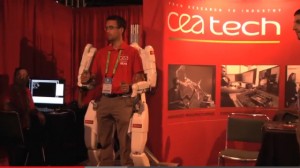Emerging Technologies at SIGGRAPH 2013 Could Yield New Markets Tomorrow
, Posted in: Inspiration, Author: nleavitt (July 28, 2013)
SIGGRAPH (Special Interest Group on Computer Graphics and Interactive Techniques) just wrapped up its 40th annual convention a few days ago; this year’s event was held in Anaheim. The convention is organized by ACM, the Association for Computing Machinery, the world’s largest educational and scientific computing society.
ACM reported that more than 17,000 artists, research scientists, gaming experts and developers, filmmakers, students, and academics from 77 countries attended; more than 180 industry organizations exhibited.
While it’s always interesting to roam the aisles to view the latest offerings of established companies, it’s just as compelling to visit the Studio and Emerging Technologies exhibits. Both are great opportunities for attendees to nose around and play with a considerable array of new techniques and media encompassing 3D printing, modeling, and animation software.
Studio, according to a SIGGRAPH spokesperson, serves as a hub for tech creation.
“Studio is a stand out program at SIGGRAPH,” said Patricia Clark, SIGGRAPH 2013 Studio Chair. “Attendees have the chance to see how experienced professionals are making the technology work for them in real life.”
Emerging Technologies, organized by Dylan Moore and his team, showcases technologies being developed in labs and studios worldwide.
A number of demos on display at the Studio could one day find real-world applications and markets. One of these was EMY (Enhancing Mobility), a full-body exoskeleton designed to help quadriplegics. EMY was created by a team of 20 researchers and engineers working for Paris-based CEA List. One key design element — the arms can be used as haptic devices.
Light-in-Flight was developed by a research team from the University of British Columbia in Canada. The portable device allows inexpensive and fast transient imaging using photonic mixer devices (PMDs). One potential real-world market, say the researchers, could include more effective ways to measure surface reflectance, which could have both industrial and research applications.
WAYLA is an eye-tracking technology developed by a research team from Carnegie Mellon University (Pittsburgh, PA) and Madeira Interactive Technologies Institute (Portugal). The team integrated eye-tracking technology into a video game. While there are a number of software companies already offering eye-tracking systems, these are primarily used for  studying human behavior (psychology, psychiatry, psycholinguistics), neurosciences and for market research. The researchers said few attempts have been made to integrate eye trackers into video games – so the market potential could be considerable.
studying human behavior (psychology, psychiatry, psycholinguistics), neurosciences and for market research. The researchers said few attempts have been made to integrate eye trackers into video games – so the market potential could be considerable.
Lastly, a research team from the University of Southern California (USC) debuted Skyfarer, a mixed-reality shoulder exercise game developed for preventing/treating shoulder pain for individuals with spinal-cord injury.
The USC team said the system is based on a second-generation integrated exercise hardware/software system that was evaluated in a biomechanical study at Rancho Los Amigos National Rehabilitation Center in Downey, CA, about 20 miles from downtown Los Angeles.
“The system consists of an adjustable metal rig outfitted with GameTrak sensors that are attached to interchangeable TheraBands (a line of progressive elastic resistance exercise products developed/manufactured by The Hygenic Corporation) and free weights. The rig can accommodate individuals with various types of manual wheelchairs and can be adjusted for arm length,” said the USC researchers.
Who knows – by the time SIGGRAPH 2014 comes around (in Vancouver, British Columbia), some of these technologies may already be in the marketplace!
Comments